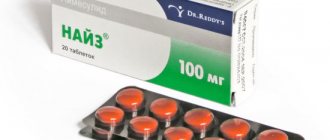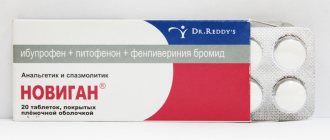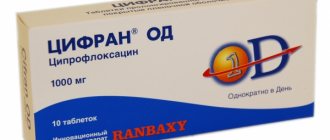If bronchitis is bacterial in nature, then antibacterial therapy is prescribed to treat it. Before prescribing antibiotics, it is necessary to identify the type of pathogen and make sure that it is not resistant to the drug.
Doctors often recommend Tsiprolet for bronchitis. The peculiarity of the drug is that pathogenic microorganisms rarely develop resistance to it.
Composition of the drug Tsiprolet
Bronchitis is a disease of the respiratory tract, with inflammation localized in the bronchi. Pathology occurs in different forms and has different causes. In half of the cases, the inflammation is infectious. Relapses, purulent sputum production, and severe deterioration of the condition are observed.
Tsiprolet is one of the antibacterial drugs prescribed for inflammation of the bronchi. The active component of the antibiotic is Ciprofloxacin, its concentration depends on:
- tablets – 250, 500 mg;
- solution for injection – 2 mg per 1 ml;
- eye drops – 3 mg per 1 ml.
In addition to the main component, the antibiotic contains a number of substances:
- magnesium stearate;
- corn starch;
- cellulose;
- sodium hydroxide;
- talc;
- silicon dioxide
The composition depends on the form of the drug and the manufacturer. There is an antibiotic on the pharmaceutical market called Ciprolet A. The combination drug contains, in addition to ciprofloxacin, tinidazole.
What effect does it have on the body?
Tsiprolet is a broad-spectrum antibiotic from the group of fluoroquinolones of synthetic origin. This second generation antibacterial drug has the following properties:
- It has a powerful bactericidal effect that allows you to eliminate microbes of different types.
- Easily penetrates tissues and cells.
- Positive changes are observed 1-2 hours after taking the medicine. A high concentration of the product can be observed after 1.5 hours.
- With long-term use of the drug, pathogenic microorganisms do not develop resistance to it.
- The drug has a bactericidal effect on the body for 12 hours.
- Beneficial microorganisms are preserved.
Penetrating into the body, the active components block the synthesis of an enzyme that promotes the development and reproduction of pathogenic microorganisms. The infection cannot survive and dies. Ciprofloxacin has a destructive effect on both reproducing bacteria and those that are dormant.
After the medicine enters the body, it is absorbed into the intestines and then penetrates the bloodstream and tissues affected by infectious agents. At the end of the action, the drug is excreted through the intestines.
Special information
Tsiprolet is not effective against streptococci, so it is not prescribed for the treatment of pathologies caused by bacteria of this group. In case of severe infection by anaerobes and staphylococcal microflora, it is better to take the medication in combination with other antibiotics, which will help enhance the therapeutic effect of ciprofloxacin.
The instructions for Tsiprolet tablets indicate that this drug can have an effect on the patient’s body, changing the ability to concentrate. Therefore, it should not be used by transport drivers and persons servicing complex mechanisms and machines. It is unacceptable to use the medication in combination with alcohol. Tsiprolet is available only with a doctor's prescription.
Indications for use
The antibacterial agent Tsiprolet is suitable for the treatment of diseases caused by various types of infectious agents. The medicine is prescribed to combat the following pathogens:
- pneumococci;
- staphylococci;
- streptococci;
- hemophilus influenzae;
- enterobacteria;
- salmonella;
- chlamydia trachomatis and others.
Bronchitis is caused by a bacterial infection, the disease is one of the main indications for the use of Tsiprolet. The antibiotic is widely used to treat pathological processes:
- pneumonia;
- tracheitis;
- sinusitis;
- angina;
- cholecystitis, cholangitis;
- cystitis;
- prostatitis, urethritis;
- pyelonephritis;
- abscess, peritonitis;
- sepsis;
- gonorrhea;
- arthritis;
- caries, periodontitis.
Tsiprolet copes with infectious pathologies of the skin and soft tissues, bones and joints, ENT organs, eyes. This antibiotic also helps with some STDs. The drug is effective against colds and flu if they are complicated by the addition of bacteria.
In opposite situations, when the disease is viral or fungal in nature, ciprofloxacin will not help.
Indications
Ciprofan tablets - what do they help with? This antibiotic is used for the treatment of complicated or uncomplicated bacterial infections that are caused by strains of microorganisms sensitive to ciprofloxacin. The remedy is indicated for the following diseases:
- urinary tract infections;
- bacterial lesions of the gastrointestinal tract;
- sepsis;
- pathologies of ENT organs, especially in case of infection with staphylococcal microflora and gram-negative bacteria, including the Pseudomonas type;
- peritonitis;
- infectious lesions of the respiratory system (for example, pneumonia), if they are caused by Enterobacter, Staphylococcus, Klebsiella, Haemophilus influenzae, Legionella or microbes of the Branhamella, Pseudomonas species;
- inflammatory infectious diseases of the genital organs in men and women (prostatitis, adnexitis);
- infections of the musculoskeletal system and skin;
- some sexually transmitted diseases (gonorrhea);
- bacterial lesions of the eyelid and conjunctiva of the eyes;
- therapy and prevention of infections in patients with low immunity (for example, with neutropenia or after treatment with immunosuppressive drugs).
Select equipment
A single dosage of solution for injection is 200-400 mg. For bacterial conjunctivitis, blepharitis and other ophthalmological diseases, Tsiprolet drops should be instilled into both eyes every 4 hours. The duration of therapy is determined individually, the course of treatment takes no more than 10 days.
Take the tablets before meals with plenty of water. The more water you drink while taking the antibiotic, the better, since the liquid prevents the deposition of salts in the excretory tract.
During the period of bearing a child and breastfeeding, Tsiprolet can be taken as a last resort, when the benefit to the mother significantly outweighs the harm to the child. If an antibiotic is used during lactation, transfer the baby to artificial feeding for the duration of therapy.
If the patient has kidney problems, the dosage of the drug should be halved. If you miss a dose, you should take the medicine sooner.
Dosage and methods of application
The antibiotic Tsiprolet is prescribed by a doctor after examining the patient. The dose of the drug is selected based on the type of infection, the severity of the disease and the patient’s condition. The dosage regimen is also influenced by the functional ability of the urinary organs and the person’s body weight (when used in adolescence and childhood).
For the most severe cases of infection and when it is impossible to take the medication in tablet form, Tsiprolet is prescribed in the form of infusion solutions. Then the intravenous infusions of the drug are gradually stopped, and the patient switches to internal administration of the medication. The tablets do not need to be chewed; they simply need to be swallowed whole and washed down with a small amount of water. Take Tsiprolet, regardless of food intake, 500-750 mg twice a day.
The duration of therapy depends on the severity of the pathology and can vary from 3 to 21 days. Usually the doctor prescribes the use of this antibiotic for a period of 7 to 14 days.
Contraindications
Tsiprolet is an antibacterial agent, so it has a number of contraindications that you should be aware of before starting therapy. The active substance can penetrate the placenta and into breast milk, so you cannot take the antibiotic during pregnancy and lactation. It is prohibited to treat bronchitis with this drug even if the body is hypersensitive to the components of the drug.
The medicine should not be used in the presence of the following conditions:
- pseudomembranous colitis;
- deficiency of glucose-6-phosphate dehydrogenase;
- pathologies of the liver, kidneys;
- heart failure.
The drug should be used with caution if you have the following health problems:
- epilepsy;
- cerebral atherosclerosis;
- cerebrovascular accident;
- psychical deviations;
- convulsive seizures.
If you have such pathologies, it is recommended to undergo an examination and consult a doctor. In old age, if possible, it is recommended to stop taking antibiotics and give preference to less powerful analogues.
You should not drink Tsiprolet as a child; you should start taking the antibacterial agent at the age of 18, when the skeletal system is fully formed.
In some cases, the medicine can be prescribed in small doses from the age of 15.
Adverse reactions
Tsiprolet is well tolerated and rarely causes complications. However, sometimes it can still lead to side effects:
- headache, dizziness;
- nausea, vomiting;
- sleep disturbance;
- dyspeptic disorders;
- allergic reaction (urticaria, itchy skin);
- heart rhythm disturbance;
- decreased blood pressure;
- decreased vision;
- increased anxiety, irritability.
In severe cases, convulsions, angioedema, and anaphylactic shock may develop. In the process of taking the drug, the activity of the body increases, which can cause impaired coordination of movements in patients with deviations in the activity of the central nervous system. Doctors do not recommend taking antibiotics before driving or handling small parts. In the blood, changes are observed such as a decrease in the number of red and white blood cells, as well as an increase in the concentration of eosinophils.
During treatment of bronchitis with Tsiprolet, the risk of tendon rupture increases. And the older the patient, the higher these risks. If you take glucocorticosteroids at the same time as an antibiotic and lead an active lifestyle. With prolonged use of tablets, bacteria that are insensitive to the effects of ciprofloxacin grow, provoking the development of candidiasis and acute intestinal inflammation.
It is important to follow the duration of the course of treatment prescribed by your doctor and not take the drug too often.
Tsiprolet (500mg)
INSTRUCTIONS for the use of the medicinal product for medical use CIPROLET®
Registration number: P N016161/01
Trade name of the drug: Tsiprolet®
International nonproprietary name of the drug: ciprofloxacin.
Dosage form: film-coated tablets
Composition Each 250 mg film-coated tablet contains: Active ingredient: ciprofloxacin hydrochloride monohydrate 291.106 mg, equivalent to ciprofloxacin 250 mg. Excipients: corn starch 50.323 mg, microcrystalline cellulose 7.486 mg, croscarmellose sodium 10.000 mg, corn starch 7.561 mg, colloidal silicon dioxide 5.000 mg, talc 5.000 mg, magnesium stearate 3.514 mg. Shell: hypromellose (6 cps) 4.800 mg, sorbic acid 0.080 mg, titanium dioxide 2.000 mg, talc 1.600 mg, macrogol-6000 1.360 mg, polysorbate-80 0.080 mg, dimethicone 0.080 mg. Each 500 mg film-coated tablet contains: Active ingredient: ciprofloxacin hydrochloride monohydrate 582.211 mg, equivalent to ciprofloxacin 500 mg. Excipients: corn starch 27.789 mg, microcrystalline cellulose 5.000 mg, croscarmellose sodium 20.000 mg, corn starch 9.500 mg, colloidal silicon dioxide 5.000 mg, talc 6.000 mg, magnesium stearate 4.500 mg. Shell: hypromellose (6 cps) 5.000 mg, sorbic acid 0.072 mg, titanium dioxide 1.784 mg, talc 1.784 mg, macrogol-6000 1.216 mg, polysorbate-80 0.072 mg, dimethicone 0.072 mg.
Description White or almost white, round, biconvex tablets with a smooth surface on both sides, film-coated. The appearance of the fracture is a white or almost white mass.
Pharmacotherapeutic group: antimicrobial agent – fluoroquinolone.
ATX code: J01MA02
Pharmacological properties Pharmacodynamics A broad-spectrum antimicrobial agent, a fluoroquinolone derivative, suppresses bacterial DNA gyrase (topoisomerases II and IV, responsible for the process of supercoiling of chromosomal DNA around nuclear RNA, which is necessary for reading genetic information), disrupts DNA synthesis, growth and division of bacteria; causes pronounced morphological changes (including cell wall and membranes) and rapid death of the bacterial cell. It has a bactericidal effect on gram-negative organisms during the period of rest and division (since it affects not only DNA gyrase, but also causes lysis of the cell wall); it acts on gram-positive microorganisms only during the period of division. Low toxicity for the cells of the macroorganism is explained by the absence of DNA gyrase in them. While taking ciprofloxacin, there is no parallel development of resistance to other antibiotics that do not belong to the group of DNA gyrase inhibitors, which makes it highly effective against bacteria that are resistant, for example, to aminoglycosides, penicillins, cephalosporins, tetracyclines and many other antibiotics. Gram-negative aerobic bacteria are sensitive to ciprofloxacin: enterobacteria (Escherichiacoli, Salmonellaspp., Shigellaspp., Citrobacterspp., Klebsiellaspp., Enterobacterspp., Proteusmirabilis, Proteusvulgaris, Serratiamarcescens, Hafniaalvei, Edwardsiellatarda, Providencia spp., Morganellamorganii, Vibriospp. , Yersiniaspp.), others gram-negative bacteria (Haemophilus spp., Pseudomonasaeruginosa, Moraxellacatarrhalis, Aeromonasspp., Pasteurellamultocida, Plesiomonasshigelloides, Campylobacterjejuni, Neisseriaspp.), some intracellular pathogens - Legionellapneumophila, Brucellaspp., Chlamydiatrachomatis, Listeria monocytogenes, Mycobacterium tuberculosis, My cobacteriumkansasii, Corynebacteriumdiphtheriae; gram-positive aerobic bacteria: Staphylococcus spp. (Staphylococcus aureus, Staphylococcus haemolyticus, Staphylococcus hominis, Staphylococcus saprophyticus), Streptococcus spp. (Streptococcus pyogenes, Streptococcus agalactiae). Most staphylococci resistant to methicillin are also resistant to ciprofloxacin. The sensitivity of Streptococcus pneumoniae, Enterococcus faecalis, Mycobacterium avium (located intracellularly) is moderate (high concentrations are required to suppress them). The following are resistant to the drug: Bacteroides fragilis, Pseudomonas cepacia, Pseudomonas maltophilia, Ureaplasma urealyticum, Clostridium difficile, Nocardia asteroides. Not effective against Treponema pallidum. Resistance develops extremely slowly, since, on the one hand, after the action of ciprofloxacin there are practically no persistent microorganisms left, and, on the other hand, bacterial cells do not have enzymes that inactivate it. Pharmacokinetics When taken orally, it is quickly and fairly completely absorbed from the gastrointestinal tract (GIT), mainly in the duodenum and jejunum. Eating slows down absorption but does not change maximum concentration (Cmax) or bioavailability. Bioavailability – 50-85%, volume of distribution – 2-3.5 l/kg, binding to plasma proteins – 20-40%. The time to reach maximum concentration (TCmax) after oral administration is 60-90 minutes, Cmax linearly depends on the dose taken and is 1.2 at doses of 250, 500, 750 and 1000 mg, respectively; 2.4; 4.3 and 5.4 μg/ml. 12 hours after oral administration of 250, 500 and 750 mg, the concentration of the drug in plasma decreases to 0.1; 0.2 and 0.4 μg/ml, respectively. Well distributed in body tissues (excluding fat-rich tissue, such as nervous tissue). The concentration in tissues is 2-12 times higher than in plasma. Therapeutic concentrations are achieved in saliva, tonsils, liver, gall bladder, bile, intestines, abdominal and pelvic organs, uterus, seminal fluid, prostate tissue, endometrium, fallopian tubes and ovaries, kidneys and urinary organs, lung tissue, bronchial secretions, bone tissue, muscles, synovial fluid and articular cartilage, peritoneal fluid, skin. It penetrates into the cerebrospinal fluid in a small amount, where the concentration in the absence of inflammation of the meninges is 6-10% of that in the blood serum, and in the presence of inflammation - 14-37%. Ciprofloxacin also penetrates well into the ocular fluid, bronchial secretions, pleura, peritoneum, lymph, and through the placenta. The concentration of ciprofloxacin in blood neutrophils is 2-7 times higher than in blood serum. Metabolized in the liver (15-30%) with the formation of low-active metabolites (oxo-, diethyl-, sulfo-, formylciprofloxacin). The half-life (T1/2) is about 3-5 hours, in chronic renal failure (CRF) - up to 12 hours. It is excreted mainly by the kidneys by tubular filtration and tubular secretion in unchanged form (40-50%) and in the form of metabolites ( 15%), the rest through the intestines. A small amount is excreted in breast milk. Renal clearance – 3-5 ml/min/kg; total clearance – 8-10 ml/min/kg. With chronic renal failure (creatinine clearance (CC) above 20 ml/min), the percentage of the drug excreted through the kidneys decreases, but accumulation in the body does not occur due to a compensatory increase in the metabolism of the drug and its excretion by the intestines.
Indications for use
Infectious and inflammatory diseases caused by microorganisms sensitive to ciprofloxacin. Adults :
- lower respiratory tract infections: acute and chronic (in the acute stage) bronchitis, pneumonia, bronchiectasis, infectious complications of cystic fibrosis;
- ENT infections: acute sinusitis;
- kidney and urinary tract infections: cystitis, pyelonephritis;
- genital infections, including adnexitis, gonorrhea, prostatitis;
- abdominal infections (bacterial infections of the gastrointestinal tract, biliary tract);
- infections of the skin and soft tissues: infected ulcers, wounds, burns, abscesses, phlegmon;
- infections of bones and joints: osteomyelitis, septic arthritis;
- sepsis and peritonitis;
- infections due to immunodeficiency that occurs during treatment with immunosuppressive drugs or in patients with neutropenia;
- prevention and treatment of pulmonary anthrax.
Children and teenagers (from 5 to 17 years):
- treatment of complications caused by Pseudomonas aeruginosa in children with cystic fibrosis;
- prevention and treatment of pulmonary anthrax (infection with Bacillus anthracis).
Contraindications for use
Hypersensitivity to ciprofloxacin and other drugs of the quinolone group and excipients, children's age (up to 18 years - until the completion of the skeletal formation process, except for the treatment of complications caused by Pseudomonas aeruginosa, in children with cystic fibrosis of the lungs from 5 to 17 years; prevention and treatment of the pulmonary form anthrax), simultaneous use with tizanidine (risk of a pronounced decrease in blood pressure, drowsiness), pregnancy, lactation (breastfeeding).
With caution Severe atherosclerosis of cerebral vessels, cerebrovascular accident, mental illness, epilepsy, severe renal and/or liver failure, old age, increased risk of prolongation of the QT interval or development of ari (for example, congenital long QT syndrome), heart disease (cardiac failure, myocardial infarction, bradycardia), electrolyte imbalance (for example, with hypokalemia, hypomagnesemia), simultaneous use of drugs that prolong the QT interval (including class IA and III antiarrhythmics, tricyclic antidepressants, macrolides, antipsychotics), simultaneous use with isoenzyme inhibitors CYP450 1A2 (including theophylline, methylxanthine, caffeine, duloxetine, clozapine, ropinirole, olanzapine), patients with a history of tendon damage during previous treatment with quinolones, myasthenia gravis, glucose-6-phosphate dehydrogenase deficiency.
Method of administration and dosage Tablets should be taken orally, regardless of meals, without chewing, with a small amount of liquid. If the drug is used on an empty stomach, the active substance is absorbed faster. In this case, the tablets should not be taken with dairy products or drinks fortified with calcium (for example, milk, yogurt, juices with a high calcium content). Calcium contained in regular food does not affect the absorption of ciprofloxacin. Recommended dosage regimen: Adults - respiratory tract infections (depending on the severity of the infection and the patient's condition): from 500 mg 2 times a day to 750 mg 2 times a day; - infections of the genitourinary system: acute, uncomplicated: from 250 mg 2 times a day to 500 mg 2 times a day; cystitis in women (before menopause): 500 mg 1 time per day; complicated: from 500 mg 2 times a day to 750 mg 2 times a day; genital infections (except gonorrhea): from 500 mg 2 times a day to 750 mg 2 times a day; gonorrhea: 500 mg once a day once; - diarrhea: 500 mg 2 times a day; - other infections (see section “Indications for use”): 500 mg 2 times a day; especially severe, life-threatening (especially in the presence of Pseudomonaspp., Staphylococcusspp., Streptococcusspp.), incl. streptococcal pneumonia, infections of bones and joints, septicemia, peritonitis: 750 mg 2 times a day. Dosage regimen in elderly patients (after 65 years): Elderly patients should be prescribed lower doses of ciprofloxacin depending on the severity of the disease and creatinine clearance. Dosage regimen for patients with renal failure: - with creatinine clearance from 30 to 60 ml/min/1.73 m2 or its concentration in blood plasma from 1.4 to 1.9 mg/100 ml, the maximum daily dose of ciprofloxacin is 1000 mg; - with creatinine clearance below 30 ml/min/1.73 m2 or plasma concentrations of 2 mg/100 ml or more, the maximum daily dose of ciprofloxacin is 500 mg; - patients with renal failure on hemodialysis: with creatinine clearance from 30 to 60 ml/min/1.73 m2 or its concentration in blood plasma from 1.4 to 1.9 mg/100 ml, the maximum daily dose of ciprofloxacin is 1000 mg; with a creatinine clearance of 30 ml/min/1.73 m2 or less or its concentration in the blood plasma of 2 mg/100 ml or more, the maximum daily dose of ciprofloxacin is 500 mg. On hemodialysis days, ciprofloxacin is taken after the procedure. Outpatients with renal failure on continuous peritoneal dialysis: maximum daily dose of ciprofloxacin is 500 mg. Patients with hepatic impairment: no dose adjustment is required. The duration of treatment depends on the severity of the disease, clinical and bacteriological control. It is important to continue treatment systematically for at least 3 days after the disappearance of fever or other clinical symptoms. Average duration of treatment: 1 day - for acute uncomplicated gonorrhea and cystitis; up to 7 days - for kidney infections, urinary tract infections, intra-abdominal infections; the entire period of neutropenia in immunocompromised patients; no more than 2 months - for osteomyelitis; from 7 to 14 days - for other infections. For infections caused by Streptococcus spp., due to the risk of late complications, treatment should continue for at least 10 days; for infections caused by Chlamydiasp., treatment should also be continued for at least 10 days. For the prevention and treatment of pulmonary anthrax - 500 mg 2 times a day for 60 days. The drug should be started immediately after suspected or confirmed infection. Children and adolescents In the absence of other prescriptions, the following dosage regimen should be followed: For the treatment of complications caused by Pseudomonas aeruginosa in children from 5 to 17 years old with cystic fibrosis - 20 mg/kg 2 times a day (maximum dose 1500 mg). Duration of treatment is 10-14 days. For pulmonary anthrax (prevention and treatment) – 15 mg/kg 2 times a day. The maximum single dose is 500 mg, daily dose is 1000 mg. The total duration of taking ciprofloxacin is 60 days. Children with renal impairment There is no information available on dosage adjustment patterns for children with renal impairment.
Side effect
Depending on the frequency of occurrence, the following groups of side effects are distinguished: frequent (>1% and <10%), infrequent (>0.1 and <1%), rare (>0.01 and <0.1%), very rare (<0.01%).
From the central and peripheral nervous system: infrequently - dizziness, headache, increased fatigue; rarely – insomnia, tremor; very rarely - anxiety, “nightmare” dreams, peripheral paralgesia (anomaly in the perception of pain), increased sweating, increased intracranial pressure, including benign intracranial hypertension, confusion, depression (which can lead to self-harmful behavior such as suicidal behavior/ thoughts, as well as attempted or successful suicide), hallucinations, as well as other manifestations of psychotic reactions (which can lead to self-injurious behavior such as suicidal acts/thoughts, as well as attempted or successful suicide), migraines, fainting states, cerebral thrombosis arteries, agitation, disorientation, paresthesia and dysesthesia, hypoesthesia, convulsions, vertigo, impaired coordination of movements, gait disturbance, hyperesthesia, peripheral neuropathy and polyneuropathy, epileptic attacks.
From the senses: infrequently - taste disturbances; rarely – visual disturbances, tinnitus, hearing loss; very rarely - impaired sense of smell, impaired color perception, impaired hearing.
From the cardiovascular system: in very rare cases - tachycardia, other heart rhythm disturbances, decreased blood pressure, prolongation of the QT interval, ventricular arrhythmias (including pirouette type).
From the digestive system: infrequently - nausea, vomiting, diarrhea, abdominal pain, flatulence, decreased appetite and amount of food taken; rarely – cholestatic jaundice (especially in patients with previous liver diseases), pancreatitis; very rarely - hepatitis, hepatonecrosis.
From the hematopoietic system: uncommon – eosinophilia, leukopenia, granulocytopenia, thrombocytopenia, anemia; very rarely - leukocytosis, thrombocytosis, hemolytic anemia, neutropenia, agranulocytosis, pancytopenia, suppression of bone marrow hematopoiesis, serum sickness.
From the urinary system: rarely - hematuria, crystalluria (primarily with alkaline urine and low diuresis), dysuria, polyuria, urinary retention, albuminuria; very rarely - glomerulonephritis, urethral bleeding, decreased nitrogen excretory function of the kidneys, interstitial nephritis, renal failure.
From the respiratory system: rarely - respiratory distress (including bronchospasm). Allergic reactions: infrequently - skin itching, urticaria, the formation of blisters accompanied by bleeding, and the appearance of small nodules that form scabs, drug fever, pinpoint hemorrhages on the skin (petechiae); rarely - swelling of the face or larynx, shortness of breath, eosinophilia, increased photosensitivity; very rarely - vasculitis, erythema nodosum, exudative erythema multiforme (including Stevens-Johnson syndrome), toxic epidermal necrolysis (Lyell's syndrome), anaphylactic reactions, anaphylactic shock. From laboratory parameters: infrequently - increased activity of liver transaminases and alkaline phosphatase, hyperbilirubinemia; rarely - changes in prothrombin levels (including hypoprothrombinemia), hyperglycemia or hypoglycemia, increased amylase activity; frequency unknown - hypercreatininemia. Other: infrequently - “flushes” of blood to the face; rarely - arthralgia, arthritis, tenosynovitis; very rarely - tendon ruptures (mainly Achilles), asthenia, myalgia, increased muscle tone, muscle weakness, exacerbation of myasthenia gravis symptoms, superinfections (candidiasis, pseudomembranous colitis); frequency unknown - acute generalized pustular exanthema, increase in international normalized ratio (in patients receiving vitamin K antagonists).
Overdose Symptoms: nausea, vomiting, confusion, mental agitation. Treatment: specific antidote is unknown. It is necessary to carefully monitor the patient's condition, perform gastric lavage and other emergency measures, and ensure sufficient fluid intake. To prevent the development of crystalluria, it is recommended to monitor renal function, including urine pH and acidity. Using hemo- or peritoneal dialysis, only a small (less than 10%) amount of the drug can be removed.
Interactions with other drugs Drugs known to prolong the QT interval Caution should be exercised when ciprofloxacin, like other fluoroquinolones, is used concomitantly in patients receiving drugs known to prolong the QT interval (e.g., class IA and III antiarrhythmics, tricyclic antidepressants, macrolides, neuroleptics). Formation of chelate compounds Simultaneous intake of tablet forms of ciprofloxacin and cation-containing drugs, mineral supplements containing calcium, magnesium, aluminum, iron; sucralfate, antacids, polymeric phosphate compounds (sevelamer, lanthanum carbonate) and drugs with a large buffer capacity (such as didanosine tablets) containing magnesium, aluminum or calcium reduce the absorption of ciprofloxacin. In such cases, ciprofloxacin should be taken either 1-2 hours before or 4 hours after taking these drugs. This restriction does not apply to drugs belonging to the class of H2-histamine receptor blockers. Ingestion of food and dairy products The concomitant use of ciprofloxacin and dairy products or mineral-fortified drinks (milk, yogurt, calcium-fortified orange juice) should be avoided as the absorption of ciprofloxacin may be reduced. However, calcium contained in other foods does not significantly affect the absorption of ciprofloxacin. Omeprazole With the combined use of ciprofloxacin and omeprazole, a slight decrease in Cmax in plasma and a decrease in the area under the concentration-time pharmacokinetic curve (AUC) may be observed. Theophylline The simultaneous use of ciprofloxacin and drugs containing theophylline may cause an undesirable increase in the concentration of theophylline in the blood plasma and, accordingly, the occurrence of theophylline-induced adverse events; in very rare cases, these adverse events can be life-threatening for the patient. If the simultaneous use of these two drugs is necessary, it is recommended to constantly monitor the concentration of theophylline in the blood plasma and, if necessary, reduce the dose of theophylline. Other xanthine derivatives The simultaneous use of ciprofloxacin and caffeine or pentoxifylline (oxpentifylline) may lead to an increase in the concentration of xanthine derivatives in the blood serum. Non-steroidal anti-inflammatory drugs The combination of very high doses of quinolones and some non-steroidal anti-inflammatory drugs (except acetylsalicylic acid) can provoke seizures. Cyclosporine With simultaneous use of ciprofloxacin and drugs containing cyclosporine, a short-term transient increase in plasma creatinine concentration was observed. In such cases, it is necessary to determine the concentration of creatinine in the blood twice a week. Oral hypoglycemic agents With simultaneous use of ciprofloxacin and oral hypoglycemic agents, mainly sulfonylureas (for example, glibenclamide, glimepiride), the development of hypoglycemia may be due to an increase in the effect of oral hypoglycemic agents. Probenecid Probenecid slows the rate of renal excretion of ciprofloxacin. The simultaneous use of ciprofloxacin and drugs containing probenecid leads to an increase in the concentration of ciprofloxacin in the blood serum. Phenytoin With the simultaneous use of ciprofloxacin and phenytoin, a change (increase or decrease) in the content of phenytoin in the blood plasma was observed. It is recommended to monitor phenytoin therapy in patients taking both drugs, including determination of phenytoin plasma levels. Methotrexate With simultaneous use of methotrexate and ciprofloxacin, the renal tubular transport of methotrexate may slow down, which may be accompanied by an increase in the concentration of methotrexate in the blood plasma. This may increase the likelihood of developing side effects of methotrexate. In this regard, patients receiving concomitant therapy with methotrexate and ciprofloxacin should be closely monitored. Tizanidine As a result of a clinical study involving healthy volunteers with simultaneous use of ciprofloxacin and drugs containing tizanidine, an increase in the concentration of tizanidine in the blood plasma was detected: an increase in Cmax by 7 times (from 4 to 21 times), an increase in AUC by 10 times (from 6 to 24 once). Hypotensive and sedative side effects are associated with increased serum concentrations of tizanidine. Therefore, the simultaneous use of ciprofloxacin and drugs containing tizanidine is contraindicated. Duloxetine During clinical studies, it was shown that the simultaneous use of duloxetine and strong inhibitors of the CYP450 1A2 isoenzyme (such as fluvoxamine) may lead to an increase in the AUC and Cmax of duloxetine. Although there is no clinical data on possible interactions with ciprofloxacin, the likelihood of such an interaction can be anticipated when ciprofloxacin and duloxetine are used concomitantly. Ropinirole The simultaneous use of ropinirole and ciprofloxacin, a moderate inhibitor of the CYP450 1A2 isoenzyme, leads to an increase in the Cmax and AUC of ropinirole by 60 and 84%, respectively. Monitor for adverse effects of ropinirole during coadministration with ciprofloxacin and for a short time after completion of combination therapy. Lidocaine In a study on healthy volunteers, it was found that the simultaneous use of drugs containing lidocaine and ciprofloxacin, a moderate inhibitor of the CYP450 1A2 isoenzyme, leads to a 22% decrease in the clearance of lidocaine when administered intravenously. Despite the good tolerability of lidocaine, when used simultaneously with ciprofloxacin, side effects may increase due to interaction. Clozapine With simultaneous use of clozapine and ciprofloxacin at a dose of 250 mg for 7 days, an increase in serum concentrations of clozapine and N-desmethylclozapine was observed by 29% and 31%, respectively. The patient's condition should be monitored and, if necessary, the dosage regimen of clozapine should be adjusted during its combined use with ciprofloxacin and for a short time after completion of combination therapy. Sildenafil When ciprofloxacin at a dose of 500 mg and sildenafil at a dose of 50 mg was used simultaneously in healthy volunteers, a 2-fold increase in the Cmax and AUC of sildenafil was observed. In this regard, the use of this combination is possible only after assessing the benefit/risk ratio. Vitamin K antagonists The combined use of ciprofloxacin and vitamin K antagonists (for example, warfarin, acenocoumarol, phenprocoumon, fluindone) may lead to an increase in their anticoagulant effect. The magnitude of this effect may vary depending on concomitant infections, age and general condition of the patient, so it is difficult to assess the effect of ciprofloxacin on increasing the international normalized ratio (INR). The INR should be monitored fairly frequently during co-administration of ciprofloxacin and vitamin K antagonists, as well as for a short time after completion of combination therapy.
Special instructions Severe infections, staphylococcal infections and infections caused by gram-positive and anaerobic bacteria When treating severe infections, staphylococcal infections and infections caused by anaerobic bacteria, ciprofloxacin should be used in combination with appropriate antibacterial agents. Infections due to Streptococcus pneumoniae Ciprofloxacin is not recommended for the treatment of infections caused by Streptococcus pneumoniae due to limited effectiveness against the pathogen. Genital tract infections For genital infections suspected of being caused by fluoroquinolone-resistant strains of Neisseria gonorrhoeae, local information on resistance to ciprofloxacin should be considered and susceptibility confirmed by laboratory tests. Cardiac disorders Ciprofloxacin has the effect of prolonging the QT interval. Given that women have a longer average QT interval compared to men, they are more sensitive to drugs that cause QT prolongation. Elderly patients also have increased sensitivity to the effects of such drugs. Use ciprofloxacin with caution in combination with drugs that prolong the QT interval (e.g., class IA and III antiarrhythmics, tricyclic antidepressants, macrolides, antipsychotics) or in patients with an increased risk of QT prolongation or development of QT syndrome (e.g., congenital long interval syndrome). QT), heart disease (heart failure, myocardial infarction, bradycardia), uncorrected electrolyte imbalance (for example, hypokalemia, hypomagnesemia). Use in children Ciprofloxacin, like other drugs of this class, causes arthropathy of large joints in animals. When analyzing the current data on the safety of ciprofloxacin in children under 18 years of age, most of whom have cystic fibrosis, no connection has been established between cartilage or joint damage with the drug. It is not recommended to use ciprofloxacin in children for the treatment of diseases other than the treatment of complications of cystic fibrosis of the lungs (in children from 5 to 17 years old) associated with Pseudomonas aeruginosa and for the treatment and prevention of pulmonary anthrax. Hypersensitivity In rare cases, after the first use, anaphylactic reactions up to anaphylactic shock may occur. In these cases, the use of ciprofloxacin should be stopped immediately and appropriate treatment should be instituted. Gastrointestinal tract If severe and prolonged diarrhea occurs during or after treatment, the diagnosis of pseudomembranous colitis should be excluded, which requires immediate discontinuation of the drug and the appointment of appropriate treatment. Hepatobiliary system Cases of liver necrosis and life-threatening liver failure have been reported with the use of ciprofloxacin. If you have symptoms of liver disease such as anorexia, jaundice, dark urine, itching, a painful abdomen, the use of ciprofloxacin should be discontinued. Patients taking ciprofloxacin who have had liver disease may experience a temporary increase in the activity of liver transaminases and alkaline phosphatase or cholestatic jaundice. Musculoskeletal system In patients with myasthenia gravis, ciprofloxacin should be used with caution, as an exacerbation of symptoms is possible. At the first signs of tendinitis (painful swelling, inflammation in the joint area), treatment with ciprofloxacin should be stopped and physical activity should be avoided. When using ciprofloxacin, cases of tendinitis and tendon rupture (mainly Achilles tendon), sometimes bilateral, may occur within the first 48 hours after the start of therapy; inflammation and tendon rupture can occur even several months after stopping treatment with ciprofloxacin. Elderly patients and patients with tendon diseases who are simultaneously treated with glucocorticosteroids have an increased risk of tendinopathy. Ciprofloxacin should be used with caution in patients with a history of tendon diseases associated with quinolones. Nervous system Ciprofloxacin, like other fluoroquinolones, can provoke seizures and lower the seizure threshold. In patients with epilepsy and a history of central nervous system diseases (lowered seizure threshold, history of seizures, cerebrovascular accidents, organic brain lesions or stroke) due to the risk of developing adverse reactions from the central nervous system, ciprofloxacin should be used only after assessing the benefit/risk ratio . Cases of status epilepticus have been reported with the use of ciprofloxacin. If seizures occur, use of the drug should be discontinued. Psychiatric reactions may occur even after the first use of fluoroquinolones, including ciprofloxacin. In rare cases, depression or psychotic reactions may progress to suicidal thoughts and self-harmful behavior, such as attempted or completed suicide; if the patient develops one of these reactions, the drug should be stopped and the doctor informed. Cases of sensory or sensorimotor neuropathy have been reported in patients taking fluoroquinolones. If symptoms such as pain, burning, tingling, numbness, or weakness occur, the patient should inform the doctor before continuing to use ciprofloxacin. Skin During the treatment period, contact with direct sunlight and UV irradiation in a solarium should be avoided. Cytochrome P450 Ciprofloxacin is a moderate inhibitor of CYP450 1A2 isoenzymes. Caution should be exercised during the simultaneous use of ciprofloxacin and drugs metabolized by these enzymes (including tizanidine, theophylline, methylxanthine, caffeine, duloxetine, ropinirole, clozapine, olanzapine), since an increase in the concentration of these drugs in the blood serum due to inhibition of their metabolism by ciprofloxacin, may cause specific adverse reactions. Prevention of crystalluria To avoid the development of crystalluria, exceeding the recommended daily dose is unacceptable; sufficient fluid intake and maintaining an acidic urine reaction are also necessary. Diagnosis of infection caused by Mycobacterium spp. In vitro, ciprofloxacin may interfere with the bacteriological study of Mycobacterium tuberculosis, inhibiting its growth, which can lead to false negative results when diagnosing this pathogen in patients taking ciprofloxacin.
Impact on the ability to drive vehicles and machinery
During the treatment period, care must be taken when driving vehicles and engaging in other potentially hazardous activities that require increased concentration and speed of psychomotor reactions.
Release form Film-coated tablets, 250 mg and 500 mg. 10 tablets in a PVC/aluminum blister. 1 or 2 blisters along with instructions for use in a cardboard pack.
Storage conditions : Protected from light at a temperature not exceeding 25 °C. Keep out of the reach of children!
Shelf life 3 years. Do not use after the expiration date stated on the packaging.
Conditions for dispensing from pharmacies By prescription.
Manufacturer Dr. Reddy's Laboratories Ltd., India Dr. Reddy's Laboratories Ltd., India
Address of the place of production 1. Survey No. 42, 45 & 46, Bachupally Village, Qutbullapur Mandal, Ranga Reddy District, Telangana State, India. 2. Khol, Nalagarh Road, Baddi, Dist. Solan, Himachal Pradesh, India.
Information about complaints and adverse drug reactions should be sent to the following address: Representative office: 115035, Moscow, Ovchinnikovskaya embankment, 20, building 1 tel. fax
Analogues of the drug
Tsiprolet is a highly effective drug that has many positive reviews. It is sold in almost any pharmacy, available without a prescription and has a low cost.
But if the drug is not suitable for any reason, then similar products can be used instead, the active ingredient of which is ciprofloxacin:
- Ciprolac;
- Quintor;
- Tsifran;
- Alcipro.
Before using any medication, please read its instructions, carefully study the contraindications, and consult a doctor.
Author: Glushko Raisa Therapist, pulmonologist, immunologist










